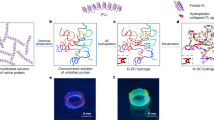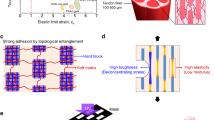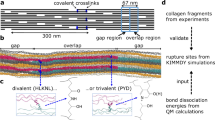Abstract
The exceptional mechanical properties of the load-bearing connection of tendon to bone rely on an intricate interplay of its biomolecular composition, microstructure and micromechanics. Here we identify that the Achilles tendon–bone insertion is characterized by an interface region of ∼500 μm with a distinct fibre organization and biomolecular composition. Within this region, we identify a heterogeneous mechanical response by micromechanical testing coupled with multiscale confocal microscopy. This leads to localized strains that can be larger than the remotely applied strain. The subset of fibres that sustain the majority of loading in the interface area changes with the angle of force application. Proteomic analysis detects enrichment of 22 proteins in the interfacial region that are predominantly involved in cartilage and skeletal development as well as proteoglycan metabolism. The presented mechanisms mark a guideline for further biomimetic strategies to rationally design hard–soft interfaces.
This is a preview of subscription content, access via your institution
Access options
Access Nature and 54 other Nature Portfolio journals
Get Nature+, our best-value online-access subscription
$29.99 / 30 days
cancel any time
Subscribe to this journal
Receive 12 print issues and online access
$259.00 per year
only $21.58 per issue
Buy this article
- Purchase on Springer Link
- Instant access to full article PDF
Prices may be subject to local taxes which are calculated during checkout





Similar content being viewed by others
References
Genin, G. M. et al. Functional grading of mineral and collagen in the attachment of tendon to bone. Biophys. J. 97, 976–985 (2009).
Wren, T., Yerby, S., Beaupré, G. & Carter, D. Mechanical properties of the human Achilles tendon. Clin. Biomech. 16, 245–251 (2001).
Thomopoulos, S., Birman, V. & Genin, G. in Structural Interfaces and Attachments in Biology (eds Thomopoulos, S., Birman, V. & Genin, G.) 3–17 (Springer, 2013).
Moffat, K. L. et al. Characterization of the structure-function relationship at the ligament-to-bone interface. Proc. Natl Acad. Sci. USA 105, 7947–7952 (2008).
Buehler, M. J. & Yung, Y. C. Deformation and failure of protein materials in physiologically extreme conditions and disease. Nat. Mater. 8, 175–188 (2009).
Bogy, D. B. Edge-bonded dissimilar orthogonal elastic wedges under normal and shear loading. J. Appl. Mech. 35, 460–466 (1968).
Benjamin, M. et al. Where tendons and ligaments meet bone: attachment sites (‘entheses’) in relation to exercise and/or mechanical load. J. Anat. 208, 471–490 (2006).
Fukashiro, S., Koomi, P., Järvinen, M. & Miyashita, M. In vivo Achilles tendon loading during jumping in humans. Eur. J. Appl. Physiol. 71, 453–458 (1995).
Pedowitz, D. & Kirwan, G. Achilles tendon ruptures. Curr. Rev. Muskuloskelet. Med. 6, 285–293 (2013).
Weatherall, J. M., Mroczek, K. & Tejwani, N. Acute Achilles tendon ruptures. Orthopedics 33, 758–764 (2010).
Buehler, M. J. Nature designs tough collagen: explaining the nanostructure of collagen fibrils. Proc. Natl Acad. Sci. USA 103, 12285–12290 (2006).
Thorpe, C. T. et al. Anatomical heterogeneity of tendon: Fascicular and interfascicular tendon compartments have distinct proteomic composition. Sci. Rep. 6, 20455 (2016).
Thorpe, C. T., Birch, H. L., Clegg, P. D. & Screen, H. R. The role of the non-collagenous matrix in tendon function. Int. J. Exp. Pathol. 94, 248–259 (2013).
Lakes, R. Materials with structural hierarchy. Nature 361, 511–515 (1993).
Benjamin, M. & Ralphs, J. R. Tendons and ligaments—an overview. Histol. Histopathol. 12, 1135–1144 (1997).
Fratzl, P. Collagen—Structure and Mechanics 1–12 (Springer, 2008).
Baer, E., Hiltner, A. & Keith, H. D. Hierarchical structure in polymeric materials. Science 235, 1015–1022 (1987).
Birk, D. E. & Bruckner, P. in Collagen (eds Brinckmann, J., Notbohm, H. & Müller, P.) 185–205 (Springer, 2005).
Benjamin, M., Kumai, T., Milz, S. & Ralphs, J. R. The skeletal attachment of tendons–tendon entheses. Comp. Biochem. Physiol. Part A 133, 931–945 (2002).
Liu, Y. et al. Modelling the mechanics of partially mineralized collagen fibrils, fibres and tissue. J. R. Soc. Interface 11, 20130835 (2014).
Buehler, M. J. Molecular nanomechanics of nascent bone: fibrillar toughening by mineralization. Nanotechnology 18, 295102 (2007).
Gautieri, A., Vesentini, S., Redaelli, A. & Buehler, M. J. Hierarchical structure and nanomechanics of collagen microfibrils from the atomistic scale up. Nano Lett. 11, 757–766 (2011).
Nair, A. K., Gautieri, A., Chang, S. W. & Buehler, M. J. Molecular mechanics of mineralized collagen fibrils in bone. Nat. Commun. 4, 1724 (2013).
Fantner, G. E. et al. Sacrificial bonds and hidden length dissipate energy as mineralized fibrils separate during bone fracture. Nat. Mater. 4, 612–616 (2005).
Jager, I. & Fratzl, P. Mineralized collagen fibrils: a mechanical model with a staggered arrangement of mineral particles. Biophys. J. 79, 1737–1746 (2000).
Wopenka, B., Kent, A., Pasteris, J. D., Yoon, Y. & Thomopoulos, S. The tendon-to-bone transition of the rotator cuff: a preliminary raman spectroscopic study documenting the gradual mineralization across the insertion in rat tissue samples. Appl. Spectrosc. 62, 1285–1294 (2008).
Thomopoulos, S., Williams, G. R., Gimbel, J. A., Favata, M. & Soslowsky, L. J. Variation of biomechanical, structural, and compositional properties along the tendon to bone insertion site. J. Orthop. Res. 21, 413–419 (2003).
Thomopoulos, S., Marquez, J. P., Weinberger, B., Birman, V. & Genin, G. M. Collagen fiber orientation at the tendon to bone insertion and its influence on stress concentrations. J. Biomech. 39, 1842–1851 (2006).
Lu, H. H. & Thomopoulos, S. Functional attachment of soft tissues to bone: development, healing, and tissue engineering. Annu. Rev. Biomed. Eng. 15, 201–226 (2013).
Liu, Y. X., Thomopoulos, S., Birman, V., Li, J. S. & Genin, G. M. Bi-material attachment through a compliant interfacial system at the tendon-to-bone insertion site. Mech. Mater. 44, 83–92 (2012).
Liu, Y. X., Birman, V., Chen, C., Thomopoulos, S. & Genin, G. M. Mechanisms of bimaterial attachment at the interface of tendon to bone. J. Eng. Mater. Technol. 133, 011006 (2011).
Galatz, L. et al. Development of the supraspinatus tendon-to-bone insertion: localized expression of extracellular matrix and growth factor genes. J. Orthop. Res. 25, 1621–1628 (2007).
Hu, Y. et al. Stochastic interdigitation as a toughening mechanism at the interface between tendon and bone. Biophys. J. 108, 431–437 (2015).
de S. e Silva, J. M. et al. Three-dimensional non-destructive soft-tissue visualization with X-ray staining micro-tomography. Sci. Rep. 5, 14088 (2015).
Balijepalli, R. G., Begley, M. R., Fleck, N. A., McMeeking, R. M. & Arzt, E. Numerical simulation of the edge stress singularity and the adhesion strength for compliant mushroom fibrils adhered to rigid substrates. Int. J. Solids Struct. 85–86, 160–171 (2016).
Schwartz, A. & Thomopoulos, S. in Structural Interfaces and Attachments in Biology (eds Thomopoulos, S., Birman, V. & Genin, G.) 229–257 (Springer, 2013).
Zhang, L. et al. A coupled fiber-matrix model demonstrates highly inhomogeneous microstructural interactions in soft tissues under tensile load. J. Biomech. Eng 135, 011008 (2013).
Huey, D. J., Hu, J. C. & Athanasiou, K. A. Unlike bone, cartilage regeneration remains elusive. Science 338, 917–921 (2012).
Mouw, J. K., Ou, G. & Weaver, V. M. Extracellular matrix assembly: a multiscale deconstruction. Nat. Rev. Mol. Cell. Biol. 15, 771–785 (2014).
Yoon, J. H. & Halper, J. Tendon proteoglycans: biochemistry and function. J. Musculoskelet. Neuronal. Interact. 5, 22–34 (2005).
Rigozzi, S., Muller, R., Stemmer, A. & Snedeker, J. G. Tendon glycosaminoglycan proteoglycan sidechains promote collagen fibril sliding-AFM observations at the nanoscale. J. Biomech. 46, 813–818 (2013).
Kuettner, K. E. & Kimura, J. H. Proteoglycans: an overview. J. Cell. Biochem. 27, 327–336 (1985).
Ritchie, R. O. The conflicts between strength and toughness. Nat. Mater. 10, 817–822 (2011).
Shaw, H. M. & Benjamin, M. Structure-function relationships of entheses in relation to mechanical load and exercise. Scand. J. Med. Sci. Sports 17, 303–315 (2007).
Deymier-Black, A. C., Pasteris, J. D., Genin, G. M. & Thomopoulos, S. Allometry of the tendon enthesis: mechanisms of load transfer between tendon and bone. J. Biomech. Eng. 137, 111005 (2015).
Han, W. M. et al. Microstructural heterogeneity directs micromechanics and mechanobiology in native and engineered fibrocartilage. Nat. Mater. 15, 477–484 (2016).
Chung, J. Y. & Chaudhury, M. K. Soft and hard adhesion. J. Adhes. 81, 1119–1145 (2007).
Lee, B. P., Messersmith, P. B., Israelachvili, J. N. & Waite, J. H. Mussel-inspired adhesives and coatings. Annu. Rev. Mater. Res. 41, 99–132 (2011).
Ho, S. P., Marshall, S. J., Ryder, M. I. & Marshall, G. W. The tooth attachment mechanism defined by structure, chemical composition and mechanical properties of collagen fibers in the periodontium. Biomaterials 28, 5238–5245 (2007).
Yuk, H., Zhang, T., Lin, S., Parada, G. A. & Zhao, X. Tough bonding of hydrogels to diverse non-porous surfaces. Nat. Mater. 15, 190–196 (2016).
Freed, L. E., Engelmayr, J., G. C., Borenstein, J. T., Moutos, F. T. & Guilak, F. Advanced material strategies for tissue engineering scaffolds. Adv. Mater. 21, 3410–3418 (2009).
Screen, H. R. et al. The influence of swelling and matrix degradation on the microstructural integrity of tendon. Acta Biomater. 2, 505–513 (2006).
Screen, H. R. C., Seto, J., Krauss, S., Boesecke, P. & Gupta, H. S. Extrafibrillar diffusion and intrafibrillar swelling at the nanoscale are associated with stress relaxation in the soft collagenous matrix tissue of tendons. Soft Matter 7, 11243–11251 (2011).
Preibisch, S., Saalfeld, S. & Tomancak, P. Globally optimal stitching of tiled 3D microscopic image acquisitions. Bioinformatics 25, 1463–1465 (2009).
Arampatzis, A., Peper, A., Bierbaum, S. & Albracht, K. Plasticity of human Achilles tendon mechanical and morphological properties in response to cyclic strain. J. Biomech. 43, 3073–3079 (2010).
Tseng, Q. et al. Spatial organization of the extracellular matrix regulates cell-cell junction positioning. Proc. Natl Acad. Sci. USA 109, 1506–1511 (2012).
Buckley, M. R., Gleghorn, J. P., Bonassar, L. J. & Cohen, I. Mapping the depth dependence of shear properties in articular cartilage. J. Biomech. 41, 2430–2437 (2008).
Raffel, M., Willert, C. E. & Kompenhans, J. Particle Image Velocimetry—A Pratical Guide (Springer, 2007).
Upton, M. L., Gilchrist, C. L., Guilak, F. & Setton, L. A. Transfer of macroscale tissue strain to microscale cell regions in the deformed meniscus. Biophys. J. 95, 2116–2124 (2008).
Cheng, V. W. T. & Screen, H. R. C. The micro-structural strain response of tendon. J. Mater. Sci. 42, 8957–8965 (2007).
Michalek, A. J., Buckley, M. R., Bonassar, L. J., Cohen, I. & Iatridis, J. C. Measurement of local strains in intervertebral disc anulus fibrosus tissue under dynamic shear: contributions of matrix fiber orientation and elastin content. J. Biomech. 42, 2279–2285 (2009).
Boyle, J. J. et al. Simple and accurate methods for quantifying deformation, disruption, and development in biological tissues. J. R. Soc. Interface 11, 20140685 (2014).
Boersema, P. J., Raijmakers, R., Lemeer, S., Mohammed, S. & Heck, A. J. Multiplex peptide stable isotope dimethyl labeling for quantitative proteomics. Nat. Protoc. 4, 484–494 (2009).
Mi, H., Muruganujan, A., Casagrande, J. T. & Thomas, P. D. Large-scale gene function analysis with the PANTHER classification system. Nat. Protoc. 8, 1551–1566 (2013).
Acknowledgements
Research was supported by the International Graduate School of Science and Engineering (L.R. and L.A.K.). The authors acknowledge the continuous support of the DFG via the Nanosystems Initiative Munich (NIM).
Author information
Authors and Affiliations
Contributions
L.R. and L.A.K. contributed equally to this work. L.R., L.A.K., H.G., J.S.-S., F.P., S.A.S., R.B. and A.R.B. designed the research. L.A.K. and J.S. performed microcomputed tomography. L.R. and L.A.K. carried out micromechanical analysis, confocal microscopy and investigated fibre composition. L.A.K. and E.K. performed proteomics experiments. L.R., L.A.K., K.W.M., R.B. and A.R.B. analysed the data and wrote the paper. All authors reviewed and revised the manuscript.
Corresponding authors
Ethics declarations
Competing interests
The authors declare no competing financial interests.
Supplementary information
Supplementary Information
Supplementary Information (PDF 688 kb)
Supplementary Information
Supplementary movie 1 (MP4 11161 kb)
Supplementary Information
Supplementary movie 2 (MP4 30500 kb)
Supplementary Information
Supplementary movie 3 (AVI 598 kb)
Supplementary Information
Supplementary Data 1 (XLSX 182 kb)
Supplementary Information
Supplementary Data 2: Matlab figure providing the full PIV data underlying Fig. 2e. (ZIP 11906 kb)
Rights and permissions
About this article
Cite this article
Rossetti, L., Kuntz, L., Kunold, E. et al. The microstructure and micromechanics of the tendon–bone insertion. Nature Mater 16, 664–670 (2017). https://doi.org/10.1038/nmat4863
Received:
Accepted:
Published:
Issue Date:
DOI: https://doi.org/10.1038/nmat4863
This article is cited by
-
The bone marrow side of axial spondyloarthritis
Nature Reviews Rheumatology (2023)
-
Bioinspired rational design of bi-material 3D printed soft-hard interfaces
Nature Communications (2023)
-
Ultra-wideband optical coherence elastography from acoustic to ultrasonic frequencies
Nature Communications (2023)
-
Hierarchical helical carbon nanotube fibre as a bone-integrating anterior cruciate ligament replacement
Nature Nanotechnology (2023)
-
Ultra-high field magnetic resonance imaging of the quadriceps tendon enthesis in healthy subjects
Surgical and Radiologic Anatomy (2023)



